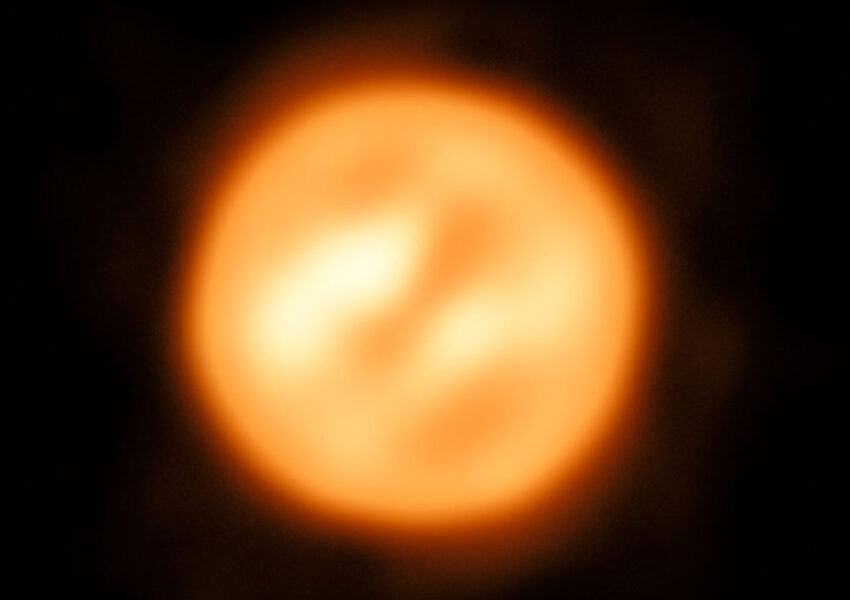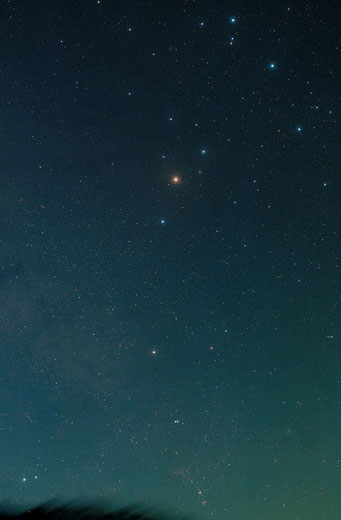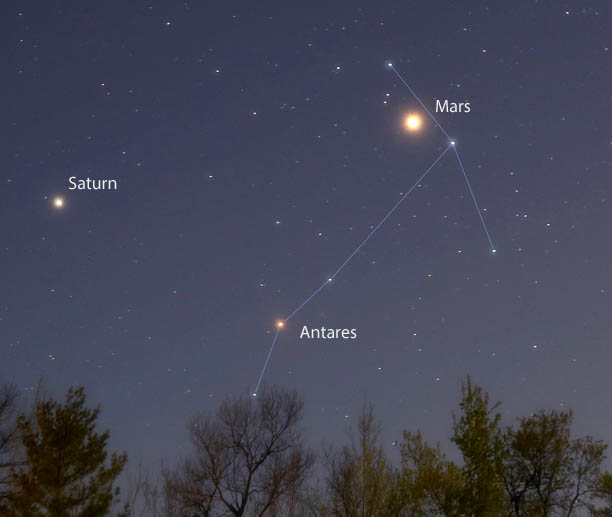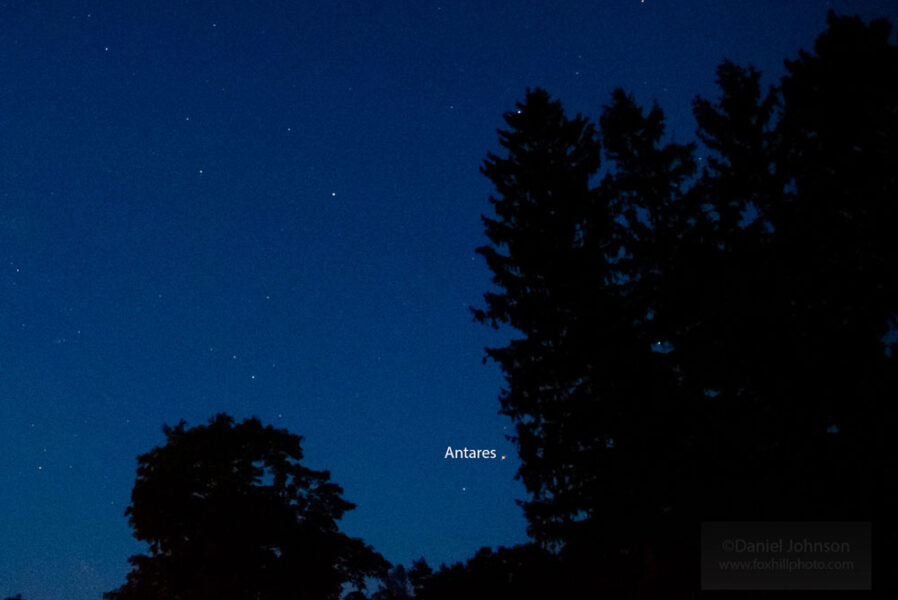Antares is a red supergiant that rises low over the southern horizon in the Northern Hemisphere.
Antares Vitals
| Official name | Antares |
| Other designations | Alpha Scorpii, HR 6134, HIP 80763, HD 148478 |
| Nicknames | - |
| Apparent Magnitude | 1.06 |
| Distance from Earth | 550 light-years |
| Type | Red supergiant of type M0.5Iab |
| Color | Red |
| Mass | ~12 M☉ |
| Radius | ~700 R☉ |
| Constellation | Scorpius |
| Right Ascension | 16h 29m 24s |
| Declination | -26° 25' 55” |
| Multiple system? | Yes |
| Variable star? | Yes |
| Exoplanets status | None known |
| Probable fate | Supernova |
Physical Characteristics
Shining boldly in the constellation Scorpius is the red supergiant star Antares — a star some 700 times larger than the Sun and so incredibly enormous that it challenges the English language. Put it this way: If the Sun were a penny lying on a basketball court, Antares would be almost the width of the court itself. Or, if you were to put Antares in place of the Sun, we’d be inside it. Its edge would be out past the orbit of Mars.
Still, it’s hard to say exactly how large it is. Like other red supergiants, such as Betelgeuse, the star is comparatively diffuse for its size, containing only around 12 times the Sun’s mass. Naturally, the outer edges of Antares’ atmosphere are particularly rarefied. Add the fact that Antares disperses some gases out into space via its stellar wind, and you can see just what a challenge it is for astronomers to gauge its diameter. But there’s no question it’s a star of breathtaking proportions. Antares is also extremely luminous, shining with the light of more than 10,000 Suns.
In 2017, the astronomers used the European Southern Observatory’s Very Large Telescope Interferometer to construct an image of Antares’ surface — an amazing achievement considering the distances involved, only accomplished for a few other (giant) stars.

ESO / K. Ohnaka
Antares is a binary system. The primary star that can be seen with your unaided eye is the red supergiant; its companion — Antares B — is a smaller main-sequence B-type star of 5th magnitude. It’s visible but easily lost in the glare of its rival and requires a fairly large telescope to see.
Eventually — and it could theoretically even happen tomorrow — Antares will run out of fuel. When that dramatic moment occurs, the force of gravity will exceed that of the Antares’ internal pressure. Antares will implode, then re-explode with the phenomenal force of a supernova, leaving behind a neutron star or black hole. Supernovae within our own galaxy are rare, even as the recent dimming and subsequent brightening of Betelgeuse had us on the edge of our collective seat. But if Antares ever does become a supernova, you can be sure it will be one of the most amazing astronomical events in modern history!
Origin / Mythology
The name Antares has an unusual origin. Most of us are familiar with the Roman names of the planets, such as Mercury, Venus, Mars. But take a moment to consider the Greek forms: Hermes, Aphrodite, and Ares. The word Ares (Mars) is nestled into the name Antares. The prefix “ant-” is also Greek, meaning “anti-” or “opposing.” So in a way, the word Antares is saying, “Not Mars!”

Akira Fujii
It makes sense: Antares is a red star, located near the ecliptic (where you’ll find planets), and approximately the same hue and brightness of Mars. You can almost imagine an ancient conversation: someone asks, “Is that Ares?” and another answers, “No, that’s anti-Ares.”
Antares is also known as the “Heart of the Scorpion” and has been for a long time. Babylonian writings from 5,000 years ago refer to the constellation as a being with a “burning sting.” In Greek lore, the Scorpion occasionally battles Orion, the Hunter, so the two of them are separated in the sky — Orion is visible in the winter, Scorpius in the summer. Scorpius was a larger constellation until about 2,100 years ago, when the Romans assigned some of the stars to Libra.
Other cultures have other names for the star and its constellation. In ancient China, Antares was called the Fire Star, for obvious reasons, and was part of a dragon constellation. In native Hawaiian stories, the constellation is instead a fishhook. In one tale, the popular folk hero Maui uses the hook to pull the Hawaiian Islands up out of the sea. Antares (Lehua Kona) sits just above the point of the hook.
In recent history, Antares was selected as the name of Apollo 14’s lunar module, which landed with astronauts Alan Shepard and Edgar Mitchell in the Fra Mauro region of the Moon in February 1970.
How to See Antares

Bob King
Summer evenings are a fine time to seek out Antares, when the star rides about as high as it will get along the southern horizon. This is particularly important if you’re trying to view Antares from more northerly latitudes. Unfortunately, there aren’t too many bright or famous stars in the vicinity to help point you in the right direction — mostly 2nd and 3rd magnitude neighbors. Fortunately, Scorpius itself is an easily recognizable constellation, although again, its position in the south can make viewing a challenge. The Moon also makes a monthly visit to Antares’ vicinity and can act as a guide at these times.

Daniel Johnson is a Wisconsin-based freelance writer and professional photographer and the co-author of over a dozen books. He’s a longtime amateur astronomer and fortunate enough to live in a rural region with excellent seeing conditions. You can view some of Dan’s photography (he does a lot of animals!) at www.foxhillphoto.com
 5
5









Comments
Henrik
September 3, 2020 at 3:10 pm
Hi
Nice story. I always liked Antares brcause of it's colour.
But should not "The suffix “ant-” " read "The prefix ant-"?
Best regards
Henrik
You must be logged in to post a comment.
Dave
September 4, 2020 at 7:36 pm
Also, "the Romans redistributed some of the stars to make Libra." The Romans were pretty powerful at one point, but I don't know if they could've done THAT. 🙂
But really, good article.
Thanks.
You must be logged in to post a comment.
Monica Young
September 4, 2020 at 8:58 pm
Indeed, I've fixed the typo!
You must be logged in to post a comment.
TenOfSwords
September 5, 2020 at 6:05 pm
Since the Sun passes several degrees north of Antares when it passes Antares on November 30 or December 1 (depending on your time zone and the year's relationship to the most recent or next upcoming leap year), Antares is invisible to Northern Hemisphere observers for a time both before and after these dates, the further north you are, the longer the period of invisibility.
You must be logged in to post a comment.
misha17
September 8, 2020 at 6:09 am
1. "In Greek lore, the Scorpion occasionally battles Orion, the Hunter, so the two of them are separated in the sky — Orion is visible in the winter, Scorpius in the summer."
Actually Scorpius and Taurus are more exactly opposite each other - Antares and Aldebaran are almost exactly 12 hrs appart in Right Ascension.
Antares is in conjunction with the Sun on Nov 30 or Dec 1st, and Aldebaran is in conjunction with the Sun around June 1st (Wikipedia).
2. "The Moon also makes a monthly visit to Antares’ vicinity and can act as a guide at these times."
Antares lies close enough to the ecliptic that the Moon can occasionally occult it. But it lies close to the southern limit of the Moon's passage, so it only has 1 "occultation season" every 18.6 years, lasting 5 years beginning and ending with occultations visible in far Northern latitudes.
You must be logged in to post a comment.
You must be logged in to post a comment.